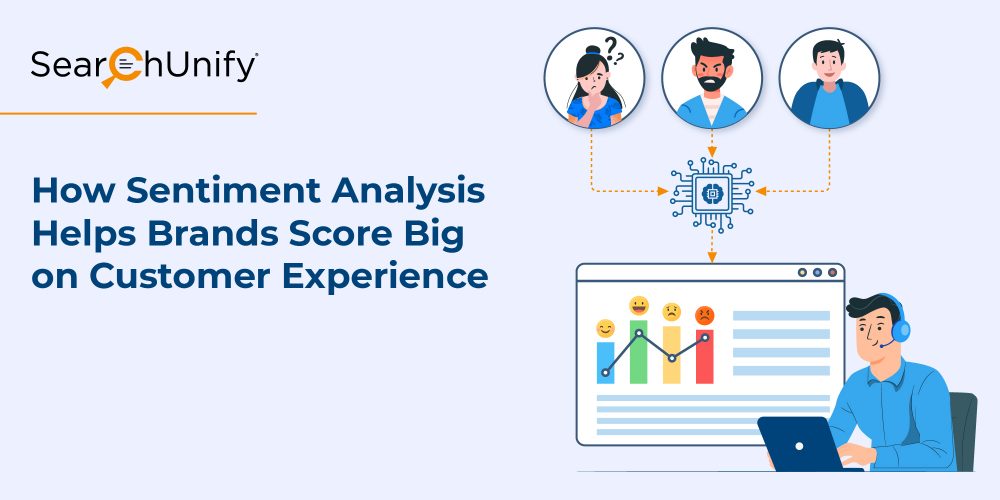
It’s a known fact that an effective customer experience strategy translates into lower customer churn rates along with improved CSAT scores and bottom lines. But how can firms evaluate the impact of their CX strategy? Is the experience really improving?
This is where feedback kicks in. Quantitative feedback like NPS is a good indicator of brand performance. But it’s the qualitative feedback that tells how people feel about a brand. And this requires going text in the form of online reviews, social media mentions, etc.
Today, almost every firm has an ocean of textual data just waiting to be analyzed. But doing so manually isn’t very feasible. With sentiment analysis, it becomes viable. This makes sentiment analysis an integral part of a CX strategy. But what exactly is sentiment analysis?
Reading Your Customers’ Minds
Sentiment analysis is a process that analyzes available data to establish your customers’ attitudes towards your company, product, or service. This helps businesses to evolve by providing insights on what their customers like and dislike.
This information is valuable as it enables organizations to manage negative feedback and work on it quickly and effectively. As a result, businesses can keep the customers delighted and retain them for the long haul.
I’d like to quote Maya Angelou here:
“People will forget what you said, people will forget what you did, but people will never forget how you made them feel.”
A recent study demonstrated how this applies in the business world: a positive experience increased the purchasing for more than 85 percent of customers. On the other hand, a negative experience led to over 70 percent of customers purchasing less than before.
So, get the experience wrong and the impact might drill a big hole in your pocket.
A Key to Deliver Superior CX
So, it’s time to answer the burning question. How exactly does sentiment analysis function as an enabler of customer experience? Let’s take a quick look at some of the ways it can help:
1. Social Listening for Proactive Assistance
Social media is now the world’s center stage. A 280‑character tweet about poor customer service can easily snowball into a PR disaster. That’s why it’s paramount for firms to stay on top of posts mentioning them. Sentiment analysis can detect negative social sentiment and help to blanket down the fire. However, there is a problem.
Most sentiment analysis tools simply identify words as positive, negative, or neutral. They seldom delve into the actual context of the text and rely on predetermined word connotations. As a result, their analysis is at times questionable. Here’s an example.
Standard sentiment analysis will consider this a positive tweet. Technologies like AI & NLP can overcome this hurdle. AI‑powered sentiment analysis understands the meaning of full sentences and then starts working on the sentiment part. As a result, negative messages are timely identified and flagged to the stakeholders, who can then work on making up for the unexpected delay.
2. Triaging Social Messages Based on Sentiment
The previous point talked about a scenario where customers express dissatisfaction over social media. But, what if they are using social media to seek help? In such cases, AI‑powered bots like Social Helper can save the day.
Every time a customer drops a message or mentions you in a post, the bot gets cracking. It scans the text to identify their underlying emotion and subject. Based on this analysis, it then applies filters to route the query to the CRM for a quick resolution.
Without this social filtering, brands stand at the risk of missing out on important requests, which can then lead to something like this:
All I wanted to do was set up a new account with @TWCable_NYC but 36hrs later I've lost the will to live.
— Patrick Stewart (@SirPatStew) September 14, 2012
3. Providing Sentiment‑Adaptive Responses on Communities
Many organizations have a dedicated customer community that serves as the breeding ground for feature ideas. But the primary objective is to enable peer learning and deflect new cases. That requires every new thread to garner engagement.
Unfortunately, that’s not always the case. A lot of enterprises have a global customer base. This means a new query might come in at any time, even during hours when most members are inactive. This is where Community Helper truly shines.
It keeps a tab on all new posts and springs into action if members don’t engage. With NLP models, it understands what the customer needs help with. Then, it starts rummaging through all your knowledge lakes to find a solution. Then finally, it uses active sentiment analysis and NLG to frame a pertinent response on a predefined sentiment‑adaptive template.
4. Framing Sentiment‑Aware Ticket Responses
Another interesting use case is for the agents. Many customers create a ticket when all other self‑service channels fail them. So, the odds are they already are a bit disappointed. And when they interact with your agent, they expect an instant resolution.
Sadly, they often have to go through the hassle of explaining their issue again. Goes without saying that it can frustrate them even more. But AI‑powered apps like Agent Helper can prevent that. Let me explain how.
They show your agents the complete customer journey till the point of case creation. That, along with sentiment analysis paints a clearer picture of how the customer might be feeling. This equips the agent to respond accordingly and improve FCR and CSAT.
The Bottom Line
Sentiment analysis offers an overview of the general sentiment associated with a brand. However, firms need to dig a little deeper to zero‑in on the underlying issues and work on eliminating them once and for all.
Emotion is one of the most powerful drivers of purchase decisions. That makes it imperative to monitor how your customers feel about you and continuously work on improving it. Only then you’ll be able to devise the most effective CX strategy.
Want to learn more interesting ways to elevate your CX? This whitepaper can help.
Whether you want to leverage AI to deliver an elevated customer and employee experience or to use it for optimized workflows, this whitepaper can help you achieve these objectives. Download it right here!



















